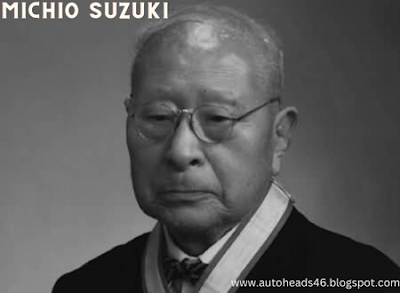History of Suzuki Japan's Origin
Suzuki: From Small beginnings in
Japan to an International Powerhouse
The story of Suzuki begins in Japan with the company's founder, Michio Suzuki. The start of his career was quite rocky, though, as he started his first company in 1919 and went bankrupt within six months of operating. He then started another company called Suzuki Loom Works, which manufactured looms for sashiko embroidery at the time. The secondtime around, things were much more successful, and the small business grew into one of the largest textile machinery manufacturers in all of Asia.
Before Hachiro
Suzuki's history began long before Hachiro Suzuki. The Suzuki legacy is rooted in the small family workshop established by Michio Suzuki, located in Hamamatsu, Shizuoka Prefecture. At the time, this region was a center for producing high-quality textiles and sewing machines. In 1909, Michio died, and his son Kihachiro took over the company as president. It soon became apparent that one of Kihachiro's most important contributions would be the founding of Suzukawa Motor Co., Ltd. in 1935 (then named Suzuki Loom Manufacturing). The company later changed its name to Suzuki Motor Corporation in 1970 when it merged with Igarashi Heavy Industries and the Ujina Plant of Showa Electric Wire Manufacturing Co., Ltd. As the Japanese economy grew and prospered during the post-war era, Suzuki expanded its manufacturing operations overseas, opening factories in Europe and Asia. Suzuki continues to flourish as an international powerhouse with a diverse portfolio of motorcycles and automobiles available worldwide. In 1949, the first Suzukimotorcycle was introduced into the North American market through a partnership with John O'Dwyer of New York. By 1955, Suzuki had exported 30 million units to 50 countries worldwide. In 2016, it was reported that Suzuki was poised to sell 10 million vehicles globally in 2020.
The Birth of Suzuki
In 1909, Michio Suzuki founded Suzuki Loom Works in Hamamatsu, Japan. The company would stay small for many years and produce only looms until the end of World War II. After the war, the company also began producing motorbikes and sewing machines. In 1952, Suzuki Loom Works merged with a Japanese transportation company called Tohatsu Motorcycle Company. Finally, the name was changed to Suzuki Motor Corporation, becoming a global powerhouse! By 1962, Suzuki had started selling cars outside Japan. It wasn't until 1978 that they established their first overseas assembly plant in the United States (and went public on the New York Stock Exchange). Today, Suzuki has been recognized by Fortune Magazine as one of the world's most admired companies and operates plants across the globe (not just in their home country). They manufacture motorcycles, automobiles, ATVs, power products, marine engines, and outboard motors. To this day, Suzuki is still managed from its headquarters in Hamamatsu, Japan.
Early Success
In the early 1900s, Suzuki was a small-scale producer of sewing machines and other products. By the 1950s,
it had grown into one of Japan's largest industrial conglomerates. In 1960, Suzuki entered the automobile market with the production of its first mini car. Two years later, they introduced their first large sedan. Within five years of introduction, Suzuki became the world's fifth largest automaker and remained for four years until 1974, when Toyota took over that position. Today, Suzuki is headquartered in Hamamatsu City on the west coast of Honshu Island and manufactures all types of vehicles, including passenger cars, light commercial trucks, motorcycles, etc. The company has 45000 employees and 35 production houses in 23 countries worldwide. It also has its research & development center. Suzuki dealerships are located across Asia, Europe, Africa, and South America, which makes them a truly global player in the automotive industry.
Later Successes
In 1954, Suzuki opened its first overseas subsidiary and established a branch office in New York City. In 1959, it was the first Japanese company to start making motorcycles on American soil, with a factory in Benicia, California.
Eventually, the firm became one of the leading motorcycle manufacturers in the world, and by 1960 had produced 890cc bikes that were among the fastest of their time. Suzuki introduced their Super Six model at this time, which was a starting point for many other motorbikes. By 1963, US-made Suzukis dominated road races across America, winning 50% of all available championships. That year, King Hussein of Jordan became the owner of a newly minted racing version of the now legendary 500cc Suzuki T500 - aptly named The Red Devil. As well as being fast, King Hussein's bike weighed in at just 185 pounds, meaning that it could get from 0-60 miles per hour in just over five seconds - faster than any bike before it.
Towards the Modern Era
In the early 20th century, Suzuki was a small engineering company, but as cars became more popular, Suzuki set its sights on becoming a significant player in the automotive industry. They launched their first car and motorcycles in 1909. In 1931 they established their first subsidiary outside of Japan. By 1955, Suzuki's focus had shifted from manufacturing primarily industrial products to automobiles for domestic use and export. Suzuki has become one of the world's largest producers of motorcycles and ATVs, both two- and four-wheel drive vehicles. In 2012, Suzuki recorded net sales of 3.2 trillion yen (USD 36 billion), with 60% coming from automobile production, 27% from motorcycles production, and 13% from power product production. The firm employs over 70,000 people worldwide and is expanding globally at 50%. It sells all over Europe, Africa, and Asia. Its operations are primarily in developing countries, where it manufactures inexpensive bikes for sale locally. It also exports $4 billion worth of parts to China annually.
In 1956 Suzuki exported its first motorcycle from Hamamatsu Factory (the current base of operations) outside Tokyo to New York City under the Jimny trademark (their nameplate). They have produced 16 million units in the Hamamatsu factory alone. More than 500,000 bikes are manufactured each year. Suzuki plans to grow their business by 50 percent this decade and make motorcycles available in new markets like Vietnam and South America.
Conclusion
Thank you for reading this blog post! If you have any queries, feel free to leave a comment below.
Also Read About This:
https://autoheads46.blogspot.com/2022/09/history-of-toyota-motors-japans-origin.html
https://autoheads46.blogspot.com/2022/10/history-of-honda-motors-about-soichiro.html




.png)
.png)

0 Comments